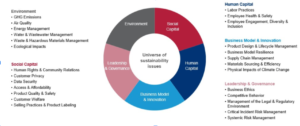Materiality Assessment in Action
Materiality Assessment in Action: Navigating ESG Priorities
1. Identify Potential Issues:
- Climate Change: Assessing carbon emissions, energy efficiency, and renewable energy adoption.
- Labor Practices: Evaluating fair wages, working conditions, and diversity in the workforce.
- Supply Chain Ethics: Examining supplier labor standards, ethical sourcing, and supply chain transparency.
- Data Security: Addressing cybersecurity measures, data privacy, and protection of customer information.

2. Stakeholder Engagement:
- Conduct surveys, interviews, and workshops with employees, customers, investors, and community members to understand their ESG priorities and concerns.
3. Prioritization:
- Analyze data gathered from stakeholder engagement to prioritize ESG issues based on:
- Financial Impact: Assess potential financial implications such as fines, decreased sales, or cost savings.
- Stakeholder Importance: Evaluate the significance of each issue to stakeholders.
- Industry Trends: Consider emerging ESG trends and best practices within the industry.
4. Materiality Matrix:
- Create a visual matrix mapping identified ESG issues based on financial impact and stakeholder importance to identify high-priority issues.
5. Formulate and Conduct Materiality Survey:
- Design survey questions addressing the significance of each ESG issue on a scale of 1-10 to gather quantitative data from stakeholders.
- Conduct meaningful discussions with stakeholders to obtain qualitative insights into the importance of each identified issue.
6. Examine Insights Gathered:
- Analyze risks and opportunities associated with addressing each material ESG issue.
- Revisit discussions with key stakeholders to validate and refine priorities.
7. Materiality Matrix Restructure:
- Index and prioritize material topics based on insights gathered, ensuring alignment with stakeholder expectations and business objectives.
8. Start Strategizing for Sustainability:
- Integrate insights from the ESG materiality assessment into corporate sustainability planning, decision-making processes, and reporting.
- Set goals, develop action plans, track progress, and communicate with stakeholders about ESG performance and accomplishments.
By following these steps, companies can effectively navigate the complexities of ESG priorities, aligning business objectives with stakeholder expectations and driving sustainable growth and value creation.

